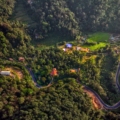Explore the Jyotirlingas of South India and Their Ancient Tales

When one talks about Jyotirlingas, we often think of the more famous temples in North and West India, such as the Somnath Jyotirlinga or Kashi Vishwanath Jyotirlinga. But did you know that South India also has some of the most awe-inspiring sacred temples dedicated to Lord Shiva? These shrines are not just Hindu pilgrimage sites but also keepers of ancient traditions, mysteries, and stories that few know about.
With all that knowledge, we will try to give you in-depth information, sharing fascinating details, practical travel tips, and surprising trivia. So, if you’re planning a spiritual journey or just interested in religious tourism, this guide is for you.
In this Blog
1. Mallikarjuna Jyotirlinga – The Shrine of Endless Echoes
Located in Srisailam, Andhra Pradesh, the Mallikarjuna Jyotirlinga is one of the oldest Hindu pilgrimage sites. But here’s something many don’t know – this temple is designed to carry sound vibrations in mysterious ways that devotees often claim that the chants and prayers create an echo that lingers longer than usual.
The temple’s architecture blends stone carvings with natural acoustics, amplifying mantras and prayers. It’s one of the few Jyotirlingas where Lord Shiva is worshipped along with Goddess Parvati, symbolising their divine union. Every carving and sculpture tells a mythological story, making the temple not just a place of worship but also a living museum of ancient art and culture.
Tips for Travellers:
- Best time to visit Srisailam: October to March is the ideal time to visit this place because the weather is pleasant.
- Don’t miss the ropeway ride across the Krishna River as it offers breathtaking views of the surrounding hills.
- Explore the nearby Akkamahadevi Caves, accessible only by boat.
- Try local sweets like ‘Ariselu’ and ‘Laddu’ sold outside the temple premises.
2. Rameshwar Jyotirlinga – The Sea-Linked Wonder
Found on Rameswaram Island in Tamil Nadu, the Rameshwar Jyotirlinga has a fascinating link to the Ramayana. Many of us know about the temple’s religious significance, but few highlight its engineering marvel.
Did you know that the temple has 22 holy wells? Yes, each well contains water that tastes different, and pilgrims believe bathing in them washes away sins. These wells are said to represent the 22 arrows in Lord Rama’s quiver. The temple is also known for its magnificent corridors, stretching 1,220 metres, making them one of the longest in the world. Lined with intricately carved pillars, these corridors add to the temple’s grandeur, offering a glimpse into its rich architectural heritage.
Tips for Travellers:
- Best time to visit Rameshwaram: November to February, when the temperature is cooler.
- Walk along the ghostly Pamban Bridge for spectacular views of the ocean.
- Try local dishes like ‘Kothu Parotta’ in the bustling streets.
- Visit Dhanushkodi, a ghost town nearby, for a surreal experience of nature and history.
- Book your homestays in Rameshwaram as early as possible.
3. Bhimashankar Jyotirlinga – The Forest Enigma
Hidden in the dense Sahyadri Hills of Maharashtra, the Bhimashankar Jyotirlinga is often overshadowed by its northern counterparts. However, the temple’s location within a wildlife sanctuary gives it an otherworldly feel.
Pilgrims visiting the temple often catch a glimpse of the Indian Giant Squirrel, a rare and sacred creature protected in the area. The temple’s design reflects ancient Hemadpanti architecture, seamlessly blending with the lush forests around it. Many believe the temple’s lingam radiates spiritual energy, while the nearby streams and waterfalls add to its peaceful and mystical charm.
Tips for Travellers:
- Best time to visit Bhimashankar: July to September for monsoon magic, but winters (November–February) are ideal for trekking.
- Carry binoculars for birdwatching.
- Visit nearby Bhorgiri Fort for a slice of history.
- Wear comfortable shoes, as some routes involve trekking through rugged terrain.
4. Kedarnath Jyotirlinga – The Himalayan Connection
Although not in South India, the Kedarnath Jyotirlinga often features in religious tourism circuits linked to Southern routes due to its connection with the Rameshwar Jyotirlinga.
Pilgrims believe visiting both Kedarnath and Rameshwaram completes the spiritual journey of seeking Lord Shiva’s blessings. The kedarnath jyotirlinga, however, surrounded by snow-capped peaks, stands as a testament to resilience, having withstood natural calamities. The trek to Kedarnath is also regarded as a test of devotion and endurance, making the pilgrimage deeply personal.
Tips for Travellers:
- Best time to visit Kedarnath: May to June or September to October.
- Acclimatise yourself to avoid altitude sickness.
- Book helicopter services early during the peak season.
- Carry warm clothing, as temperatures can drop drastically.
5. Omkareshwar Jyotirlinga – The Island Mystery
Situated on the Mandhata Island in Madhya Pradesh, the Omkareshwar Jyotirlinga isn’t technically in the south but is frequently visited as part of a Hindu pilgrimage trail from the south.
The island is shaped like the symbol ‘Om,’ adding mystical significance. Legends also say the temple’s lingam appeared naturally (Swayambhu). Not just that, the nearby Mamleshwar temple is equally revered, making the entire area a dual pilgrimage site.
Tips for Travellers:
- Best time to visit Omkareshwar: October to March.
- Take a boat ride around the island for spectacular views.
- Attend the evening aarti for a truly divine experience.
- Carry a camera to capture the mesmerising reflections of the temple in the Narmada River.
The Jyotirlingas in South India are more than just sacred temples; they are living repositories of ancient wisdom, culture, and stories that continue to inspire millions. Whether you’re setting out on a spiritual journey or looking for enriching religious tourism experiences, these temples offer much more than prayers—they leave you with unforgettable memories.
If you’re planning your trip, remember that the best time to visit South India is during the cooler months from October to February. Carry essentials, respect local customs, and be ready for an adventure that’s as much about self-discovery as it is about devotion.
Article by: Ruben Saha
Image credits: Gúŕú śàí Pŕàkèśh via Unsplash





